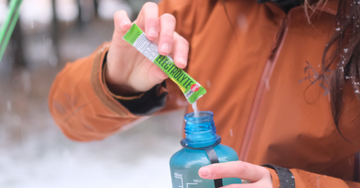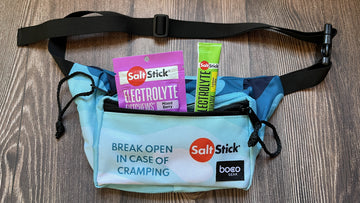 At SaltStick, we are proud to sponsor top athletes in the fields of triathlon, running, tennis and more. We are inspired by our athletes and admire the hard work and time they have dedicated to achieving success.
Because we hope our athletes’ performances will serve as motivation as you pursue your own fitness and life journey, we enjoy sharing their stories. This week’s blog post features Sam Hitch, who in the summer of 2016, completed a triathlon across America, traveling from Yorktown, Virginia, to San Francisco, California, to raise money and awareness for the Lustgarten Foundation, a leading pancreatic cancer foundation.
At SaltStick, we are proud to sponsor top athletes in the fields of triathlon, running, tennis and more. We are inspired by our athletes and admire the hard work and time they have dedicated to achieving success.
Because we hope our athletes’ performances will serve as motivation as you pursue your own fitness and life journey, we enjoy sharing their stories. This week’s blog post features Sam Hitch, who in the summer of 2016, completed a triathlon across America, traveling from Yorktown, Virginia, to San Francisco, California, to raise money and awareness for the Lustgarten Foundation, a leading pancreatic cancer foundation.
SaltStick-sponsored triathlete Sam Hitch is no stranger to success: He’s raised more than $57,000 for various charitable causes through his participation in endurance events, proving that it’s possible to combine training and racing with a greater cause. In addition to TriAmerica2016 (a 3,906-mile triathlon across the United States in 50 days), he’s also completed long-distance triathlon races and the World’s Toughest Mudder.
To learn more about
Sam, visit his Athlete Sponsor page
here.
Sam’s journey into triathlon:
Growing up, Sam played soccer, which built a strong aerobic base that would later serve him well in endurance sports. Even though he did not participate in swimming, cycling or running when he was younger, he felt the pull after seeing friends and family members enjoying triathlon. Very quickly, he became hooked.
Since venturing into triathlon, Sam has found it to be a useful outlet for his passion for adventure, physical and mental challenges. In addition to long-distance triathlon, Sam has participated in trail-running, road-running and obstacle course races.
Sam’s experience in the sport took a dramatic leap forward in 2016, when he decided to celebrate his college graduation by completing a self-designed triathlon across the United States. Known as “TriAmerica2016,” Sam’s journey took him from Virginia to California, which resulted in a 105-mile swim, 3,030-mile bike, and 771-mile run. In addition to the mere physical feat, Sam also was able to raise funds for the
Lustgarten Foundation, a leading pancreatic cancer foundation.
Currently, Sam lives and trains in Manhattan.
On training:
To train for his massive journey across the United States, Sam followed a periodized plan that emphasized strength and a cardiovascular base. After completing Ironman Texas, Sam stopped endurance training (to let his body recover) and shifted his focus to weight training for strength.
After he made the decision to move forward with TriAmerica2016, Sam moved back to endurance sports, building a volume of endurance training across the three sports until he was working out 25-32 hours a week.
Then, in the final weeks before the challenge, he changed his weekly training cycle so he focused on a single sport for consecutive days. For instance, he might swim four times a day for two days, before moving on to bike-only days. Because the final event would involve this type of routine (i.e. performing one sport over and over for a week or more), he decided a similar training plan would best prepare him for his journey.
TriAmerica2016 required incredible effort, both physical and mental. Even now, Sam recognizes the importance of incorporating “mental toughness training” into his routine.
“I have personally found mental toughness to simultaneously be the greatest requirement and product of endurance sports," Sam says. "By intentionally challenging ourselves at higher intensities and longer distances, I think we can improve our ability to mentally cope with anything.
“Some of the most beneficial training sessions I have are what I call CDRs – long runs outside when it is Cold, Dark, and Raining. These CDRs and similar sessions are more mental than physical and are essential for getting through the inevitable dark periods of a race.”
On motivation:
Sam is a highly motivated individual, but he is the first to point out most of this motivation comes from practice.
“I approach motivation from a short-term perspective and goals from a mid- to long-term perspective,” Sam says. “In order to remain consistently motivated, I focus on very short-term decisions (i.e. having a great training session, eating well throughout the day, hitting my weekly mileage) that enable me to achieve intermediate goals, which will ultimately put me in a position to achieve long-term goals. Understanding the compounding effect of short-term decisions is highly motivating for me.”
Additionally, he enjoys the routine aspects of training and racing. To him, training is his “me time,” allowing him to relax, relieve stress and enjoy exploring Manhattan.
Finally, Sam relies on his family to provide motivation and support to continue his efforts in endurance sports.
“My immediate family members were the first to expose me to endurance sports and have continued to support, cheer, crew, pace and inspire me ever since,” Sam says.
On nutrition:
While Sam does not studiously follow any particular diet, his is very aware of what he eats and how that affects his performance. A fan of intermittent fasting, Sam consumes most of his calories from meal-replacement drinks and clean eating practices.
“I have noticed faster recovery times and better weight management while focusing on nutrition,” Sam says. “For racing, I keep it simple. I eat 10 to 20 percent more several days leading up to an event and then only use products I have trained with during the race.”
How SaltStick helps Sam perform: Sam is a big fan of SaltStick, and he routinely consumes the suggested one to two SaltStick Caps per hour, depending on length and intensity of his workout or race.
“I have been very fortunate to learn from the experiences (bonks) of others,” Sam says. “As a result, I have never competed in a race longer than a half-marathon without SaltStick and have never hit a hydration-based wall.”
During TriAmerica2016, Sam ran from Utah to San Francisco (771 miles) from mid-July to early August. Even though he used what he calls “an extremely basic hydration plan,” he never experienced any hydration problems during the 19.5 days of running more roughly eight hours per day.
“Don’t fix anything that already works,” he says.
Sam’s advice to people considering an endurance challenge:
Sam’s wealth of experience has provided him with several tips he offers to new athletes.
-
Start small: “I always recommend starting small in order to physically build your muscular and cardiovascular base and mental endurance – all of which are required to continue and increase your training,” he says.
-
Be consistent: It takes a while for the body to adapt to endurance training, and consistency is the best way to see improvement over time.
-
Be realistic: “Thoroughly analyze your weaknesses, gradually align your actions with who you want to become, and create goals that are truly attainable,” he says.
-
Be flexible: It is important that you enjoy what you are doing. No one is asking you to participate in endurance races, and if training becomes a chore, you risk quitting or burnout.
-
No more music: “I recommend no longer listening to music while you exercise,” Sam says. “Yes, music can be a great distraction, but to really improve you need to focus on pace, form and listening to your body. Two added bonuses are learning how to disassociate without the use of music and experiencing completely natural flow states.”
For the scientifically-inclined among us, Sam recommends researching three positive psychology concepts: growth mindset, deliberate practice, and grit. “Academics on these topics have helped me to begin understanding what enables the average person to do what is far from average,” he says.
Thank you Sam Hitch!

 At SaltStick, we are proud to sponsor top athletes in the fields of triathlon, running, tennis and more. We are inspired by our athletes and admire the hard work and time they have dedicated to achieving success.
Because we hope our athletes’ performances will serve as motivation as you pursue your own fitness and life journey, we enjoy sharing their stories. This week’s blog post features Sam Hitch, who in the summer of 2016, completed a triathlon across America, traveling from Yorktown, Virginia, to San Francisco, California, to raise money and awareness for the Lustgarten Foundation, a leading pancreatic cancer foundation.
SaltStick-sponsored triathlete Sam Hitch is no stranger to success: He’s raised more than $57,000 for various charitable causes through his participation in endurance events, proving that it’s possible to combine training and racing with a greater cause. In addition to TriAmerica2016 (a 3,906-mile triathlon across the United States in 50 days), he’s also completed long-distance triathlon races and the World’s Toughest Mudder.
To learn more about Sam, visit his Athlete Sponsor page here.
At SaltStick, we are proud to sponsor top athletes in the fields of triathlon, running, tennis and more. We are inspired by our athletes and admire the hard work and time they have dedicated to achieving success.
Because we hope our athletes’ performances will serve as motivation as you pursue your own fitness and life journey, we enjoy sharing their stories. This week’s blog post features Sam Hitch, who in the summer of 2016, completed a triathlon across America, traveling from Yorktown, Virginia, to San Francisco, California, to raise money and awareness for the Lustgarten Foundation, a leading pancreatic cancer foundation.
SaltStick-sponsored triathlete Sam Hitch is no stranger to success: He’s raised more than $57,000 for various charitable causes through his participation in endurance events, proving that it’s possible to combine training and racing with a greater cause. In addition to TriAmerica2016 (a 3,906-mile triathlon across the United States in 50 days), he’s also completed long-distance triathlon races and the World’s Toughest Mudder.
To learn more about Sam, visit his Athlete Sponsor page here.








